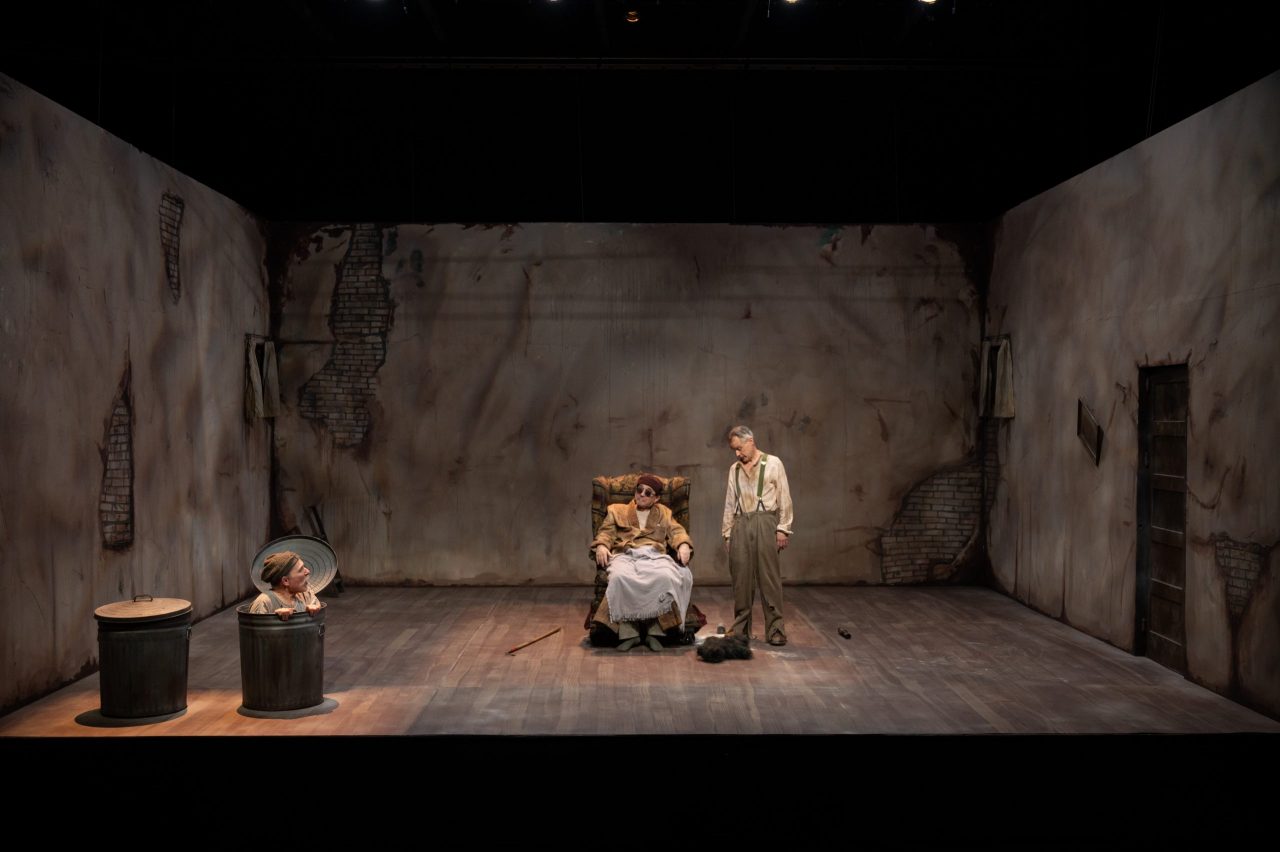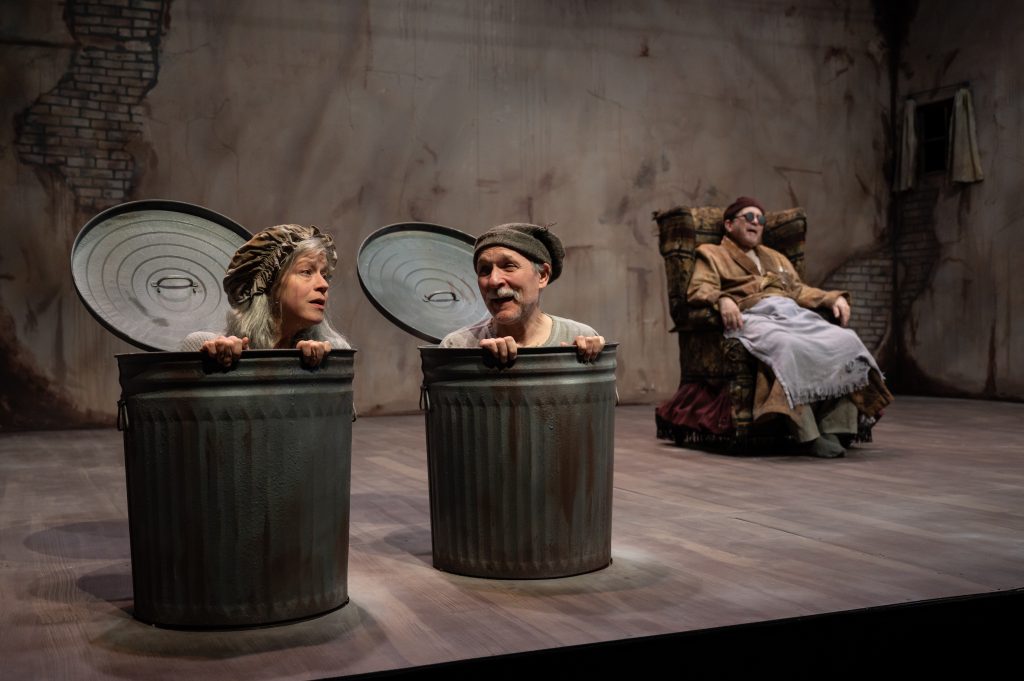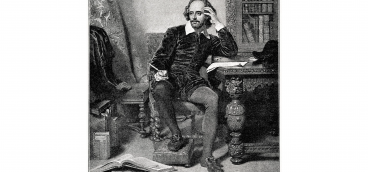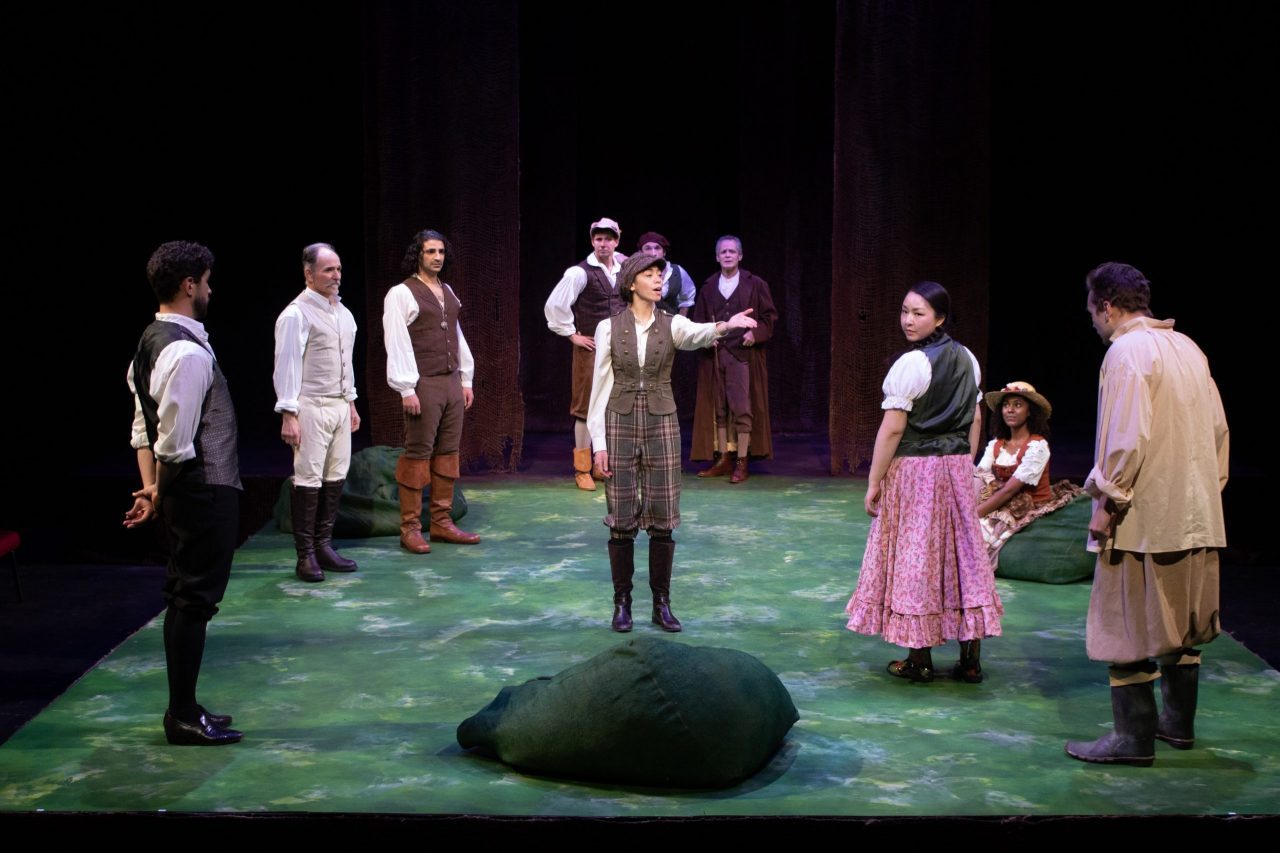
“Endgame” is an enormous play set in a small room occupied by four persons who speak absurdly, recounting stories or delivering monologues apropos of nothing — as nursing home residents often do — prompted by memories that float into their minds from the effects of old age, disease, or boredom. Written by Samuel Beckett as the follow-up to his masterwork, “Waiting for Godot,” (1952), “Endgame” (1957) may even be more profound, much as Shakespeare’s “King Lear” is often considered the stronger play when compared with his masterwork “Hamlet,” also composed about five years prior.
The action transpires in a decrepit, dimly lit space – a dungeon of sorts with only two meager windows and a doorway to a tiny kitchen offstage – where these people reside in what we can only guess is some kind of post-apocalyptic, timeless state. Beckett tells us so little that almost any interpretation is welcome: we could easily be in a facility for retired actors, perhaps in a room shutoff or forgotten, “stage-managed” or “directed” by the central character called Hamm (Martin Giles) who could be an old theatrical “ham” reciting scraps of dialogue from plays acted long ago. Or not. Perhaps more than any writer, Beckett follows philosopher Ludwig Wittgenstein’s maxim, “Anything your reader can do for himself leave to him.”
As abstract and devoid of context as “Endgame” is, its power resides in the harrowing details of senescence and degradation evinced by the characters, details that Beckett was utterly familiar with after the experience of caring for his dying mother years before and, more recently his brother, who succumbed slowly and painfully to cancer, which directly led to the gestation of this work. If you’ve ever been a caregiver for someone in an end-of-life situation, you’ll find much to relate to in the reality of how these characters suffer, no matter how artificial the environment in which they are framed. For example, Hamm continually begs for his painkillers throughout the performance.
What PICT Classic Theatre does with this play is revelatory; you may see different productions of “Endgame” in your lifetime, but you will never see a stronger one. Like most of Beckett’s plays and novels “Endgame” is many things, but it is not one thing, and letting the possibility of infinite interpretation (especially in our age of didactic art) unfold before viewers is a rare achievement. Never have I seen an entire audience leave the theater in such a universally stunned manner; it’s as if director Alan Stanford handed an existential toolkit to each person, allowing them to confront their own mortality through the synthesis of acting, staging, and design presented in the 100 minutes of this one-act play.

Even more critical to the success and impact of this show is the acting. The four artists – and I use this word with full aesthetic intent – are each brilliant in their portrayals. Martin Giles, as the aforementioned Hamm, brings a nuanced precision to the evocation of this blind, frustrated, old man who cannot walk. Confined as he is to an armchair on castors, there is an enormity to the minute gesticulations of his hands folding, for example, his bloody pocket handkerchief – a kind of symbolic Veronica veil – and the pathetic handling of his three-legged, toy dog, perhaps the only thing he cares for in the world.
Giles’ soliloquies are visceral in a way rarely heard, as he speaks like a blind man would, not really knowing who is in the room with him, but also as an old actor suffering from dementia might, not really sure if he is on stage – in a play-within-the-play – which is deliciously ambiguous and all the more moving.
But it is in the verbal exchanges that these actors show their highest virtuosity, whether between Hamm and his servant/ward Clov (James FitzGerald), or Hamm’s disintegrating parents who live in trashcans in the same room, Nagg (Ken Bolden), and Nell (Karen Baum).
One reason these actors don’t step on each other’s lines is that they’re actually listening to one other – no easy task when the stage blocking rarely positions them face-to-face.
FitzGerald literally nails Clov, and you’ll have to pardon the pun as clou is French for nail, the language in which Beckett originally wrote the play, and thus balances Hamm as the abbreviation for “hammer.” I had always held David Thewlis’ portrayal of this character — in the 2000 film version directed by Conor McPherson — as the best I’ve ever seen, but FitzGerald achieves a level of insouciant resignation which surpasses that performance and begins to approach the rarified landscape of silent film masters such as Buster Keaton. His repetitions, and there are many written into the play, such as the ladder sequences, are never banal. You see the same action performed again and again, but it always looks organic. Like Keaton, like Chaplin, we watch this character with fascination, even though we know, in the classic definition of “The Clown” he will never advance the action. But we hear his steps like heartbeats which may never amount to anything, but infuse the room with life, even if it has no purpose.
Director Stanford never lets Clov take the direct route across the stage, instead diverting him behind the central chair where Hamm sits, in a kind of dogleg angle, eschewing the hypotenuse path by which he could more easily reach the two trashcans, downstage, where Nagg and Nell reside. This serves to reinforce the absurdist nature of this world, where nothing transpires in obvious fashion.
In one of the most daring conceits of 20th century avant-garde theatre, Beckett has Hamm’s parents – both of whom lost their legs in a tandem bicycle accident – live in these metal cans. There are no beds in such a world. Hamm, who cannot stand, sits, and Clov, who cannot sit, simply stands. Thus the parents are ensconced in their bins with floors of sand, much more like litterboxes than any type of human resting place.
The idea for putting performers in such “barrels” may have resulted from a remark by the poet and playwright William Butler Yeats, who felt that actors should be confined in such a way as to keep them from “expression.” And this trope has become an archetype, evolving just 12 years later into what is now the internationally recognized puppet character Oscar the Grouch, who lives in a trash can on the television show Sesame Street.
Ken Bolden’s Nagg moves in this confined space like a man content with a universe measured in inches, and the plasticity of his face is remarkable. The way he turns his body using only the strength of his hands makes you believe you’re watching just half-a-torso, not a full person standing through a trap door.

Karen Baum’s Nell, as Nagg’s wife, exudes a life force so vibrant she almost swallows all the energy on stage every time she speaks. She’s such an authoritative actor, one can only imagine what she would do with the primary role in a Beckett play such as Winnie in “Happy Days.” She does more than balance all the male energy surrounding her character; actually she tips the stage towards herself with every line delivered.
This family, if it could be called that, makes the families in Sam Shepard plays look like the Brady Bunch. Hamm calls his father “accursed progenitor!” which is about the closest to a term of endearment he can muster.
The technical aspects of the production are as subtle as they are effective. Nicole White’s lighting design is so rich it’s like stepping inside cinematography: we are not watching events on a stage, we are living inside the stage, gasping the same, petrified air as the characters, like archeologists entering a long-buried catacomb.
Just as ethereal are Kris Buggey’s sound treatments. It wasn’t until the end of the show that I realized I had never heard silence as its own modality. For a Beckett play, which thrives on silence, this is an essential quality.
Joan Markert’s costumes are so worn and soiled it’s unnerving. Many productions of “Endgame” try to go over the top and hit some kind of futuristic, designer-slum look, but these garments are imbued with such a sense of exhaustion, it’s as if the souls of these destitute beings have crawled outside their bodies and are falling apart at the seams.
Domenico Lagamba also deserves special praise as the scenic artist. The walls, floor, and curtains are decayed with a kind of lifelessness so old we believe that this is a room in which time has stopped. We’re not looking into something evocative like hell, we’re looking at something much more dispiriting, like the abyss. It’s as if our eyes have adjusted to the darkness of life’s futility, and we’re in that grey-lit world the philosopher Friedrich Nietzsche talks about when he warns, “If you gaze long enough into an abyss, the abyss will gaze back into you.”
Perhaps the most salient decision regarding the set – designed by director Stanford – is the placement of the two windows on the east and west walls of the stage. In productions where the windows are both placed on the north wall, that is on either side of Hamm’s chair, the effect 1) denotes two eyes, with all the attendant metaphorical implications, 2) lessens the time it takes Clov to constantly walk between them to open and close the curtains, and 3) creates greater consistency with the absurdist nature of everything else, because it makes the two different views described in the same northerly direction – one of sea and one of land – ironic, instead of how it is portrayed here, sea to the west and land to the east, which is normal. Beckett’s world is never normal.
And such matters are never trivial to this playwright. In fact, the eminent Beckett scholar Hugh Kenner relates how when he once visited him in London prior to a production of “Endgame,” Beckett was obsessing over the number of steps between the windows and how this impacted Clov’s speeches while he moved his ladder back and forth between them.
This is a perfect metaphor for what this work is trying to achieve. “Endgame” is a spectacle of details, of words, of contradictions, and absurd ironies. It is devoid of messages, of dictums, of philosophies. That PICT Theatre not only honors, but celebrates this, makes it the rarest kind of theatrical opportunity available these days – a chance to experience the sublime.
“ENDGAME” runs through May 28th in the Fred Rogers Studio at WQED, Oakland, $20 – $48. 412-561-6000, or www.picttheatre.org












